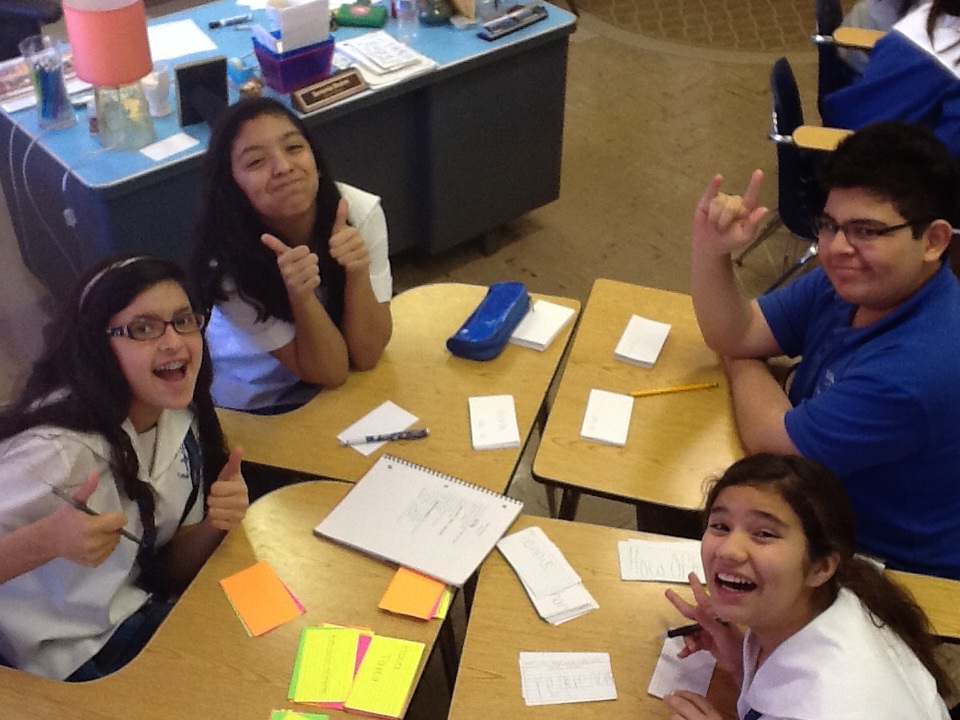Poet-in-residence Dean Kostos brings middle-schoolers into the process of crafting the elusive “voice” students hear so much about. By considering poet May Swenson’s choices in form and use of literary devices, students see how one author developed her voice unconventionally, and how they themselves can play with the rules of writing to develop a voice all their own.
Lesson Overview
Grade(s) Taught: 6th–8th
Genre(s) Taught: Poetry, prose
Download: Travel Poetry
Common Core State Standards: (Refer to writing standards at English Language Arts Standards > Writing > Grade 6, English Language Arts Standards > Writing > Grade 7, English Language Arts Standards > Writing > Grade 8; and to reading standards at English Language Arts Standards > Reading Literature > Grade 6, English Language Arts Standards > Reading Literature > Grade 7, and English Language Arts Standards > Reading Literature > Grade 8)
- ELA-LITERACY.W.6-8.3
Write narratives to develop real or imagined experiences or events using effective technique, relevant descriptive details, and well-structured event sequences. - CCSS ELA-LITERACY.RL.6.4
Determine the meaning of words and phrases as they are used in a text, including figurative and connotative meanings; analyze the impact of a specific word choice on meaning and tone.
- CCSS ELA-LITERACY.RL.7.4
Determine the meaning of words and phrases as they are used in a text, including figurative and connotative meanings; analyze the impact of rhymes and other repetitions of sounds (e.g., alliteration) on a specific verse or stanza of a poem or section of a story or drama.
- ELA-LITERACY.RL.8.5
Determine the meaning of words and phrases as they are used in a text, including figurative and connotative meanings; analyze the impact of specific word choices on meaning and tone, including analogies or allusions to other texts.
Guiding Questions:
- Does a travel poem have to be realistic, like a car or subway? Or can it be about the way a thought travels through our minds, or the way music fills a room?
- How do Swenson’s choices on where to use metaphor and where to use simile affect the poem?
- What is form?
- How can we make sure that our poems come alive with a “voice” as hers does? How can the structures and the line breaks in our poems emphasize what we want to say?
LESSON
Introduction: I pass around copies of the Mary Swenson “Riding the A” poem and prompt handout. I read the poem aloud one time and then ask that students do a whole class read around, where each student reads one line at a time.
I initiate a discussion, asking the students how the poem sounded going line by line, as opposed to being read by one consistent voice. Ask them what they noticed about where the lines break off. By getting the kids to think about line breaks, they start to look at the way a poet uses words as the “stuff” of their writing, just the way a painter uses paint.
Swenson’s poem uses both metaphor and simile. We identify and examine her choices, imagining how different the poem would be had she chosen differently. I explain that nothing is truly random and that poets’ line breaks and stanzaic structures are closely connected to the meaning, the movement, the emphases, and the anticipation they hope to convey. We discuss the form of the poem, how it is achieved, and how it serves the poet.
Main Activity: Finally, I ask the students to imagine if this poem had been formatted differently, even as paragraphs. Swenson’s line breaks are so fresh, especially when she gives us the delightful word play of “along / a long” (23-24). I invite the students to restructure Swenson’s poem as they see fit, and see how this changes the mood and meaning of the poem.
Keeping in mind Swenson’s unique style and form, I ask students to write their own poems about traveling, based on one of the prompts on their handout. They are to explore variation in metaphor and simile.
Sensory details (including all the senses) are encouraged. I note that we have more words for verbal imagery, but stress that auditory imagery and olfactory imagery can be very powerful, if articulated well.
Closing: I ask students to share what they are going to be thinking about as they travel home from school today.
Materials:
“Riding the A” poem and prompt handout
Vocabulary:
Form, metaphor, simile, emphasis, stanzaic structure
Multi-Modal Approaches to Learning:
This lesson appeals to a variety of learning styles, including aural (hearing the poem read aloud in two different ways); linguistic (reading lines of the poem aloud themselves); interpersonal (class discussion); intrapersonal (independent writing and restructuring); and kinesthetic (the descriptions in the poem and the encouraged use of sensory detail).



